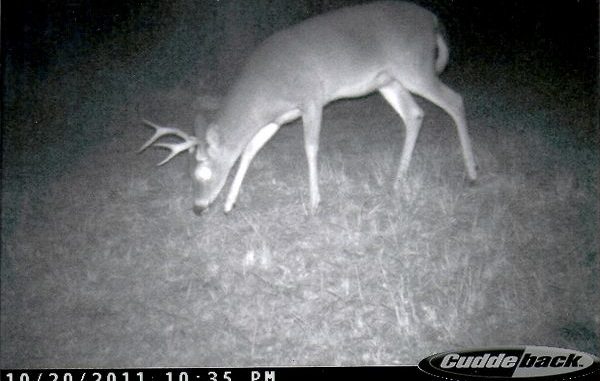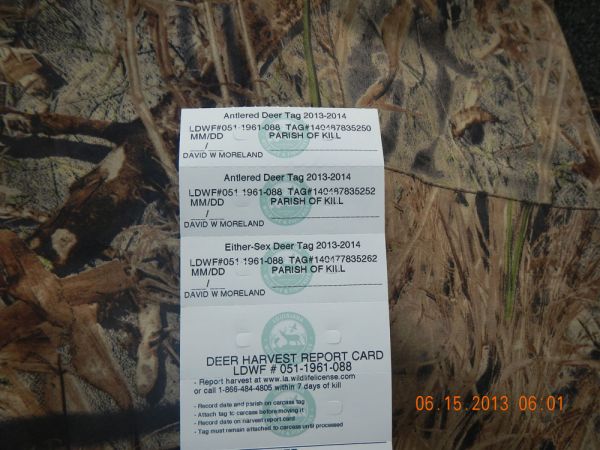
While doe days are coming back, the doe limit is actually increasing
It is hard to believe that the 2013-14 hunting season is just around the corner. Now is the time to be making final preparations for the upcoming season, one of which should be to purchase your new hunting license and obtain deer tags, which are required of all deer hunters.
Of course, if you have a lifetime hunting license all you need to do is get your deer tags and if you hunt migratory birds you also need to get the free HIP certification that is mandatory for dove and waterfowl hunters.
When the Louisiana Department of Wildlife and Fisheries first began offering the lifetime licenses I opted not to go that route, continuing to purchase the annual hunting and fishing license. I had started collecting and keeping my old licenses and I did not want to stop, so I would just pay the extra for my resident licenses.
But the lifetime license is a great deal, especially if you are young; it hasn’t been great for the department, but perhaps over time as people phase out of hunting the department will benefit from the program.
I also looked forward to the day I turned 60 and can purchase a senior license for $5. As you recall, in the old days when a resident turned 60 he could just hunt and fish free, but this changed in 2000 as a way for the department to benefit from increased license sales at a time when hunter numbers were beginning to drop off.
Because I hunt hogs on our property year-round I bought my new licenses in June. If you have purchased your licenses and hunt deer, you should have noticed that instead of three antlered buck tags you now have two antlered buck tags and one either-sex tag, in addition to your three antlerless deer tags. The either-sex deer tag can be used for either an antlered buck or an antlerless deer — you get to decide.
If you keep up with the LDWF process of establishing hunting seasons every year, you probably know the agency is making changes in some of the deer hunting areas, and rather than every day being a doe day, the areas will have a specified number of doe days on which antlerless deer can legally be taken.
I hunt in East Feliciana Parish, which is in Area 1, and this parish along with many of the other Florida Parishes are being placed in Area 4 and will have specified doe days.
LDWF has seen a decline in the deer harvest in some areas around the state and believes this is due to declines in the deer populations in these areas; therefore, they have made these changes as a way of decreasing the doe harvest that should result in an increase of deer in the population.
Of course, if habitat conditions have declined, deer populations probably will not benefit from a reduced harvest.
Some will ask why, if deer populations are declining and reducing the deer harvest is in order, LDWF is giving opportunities to hunters to harvest more does?

Let me first say that just because LDWF is giving opportunities to hunters to shoot more does doesn’t mean all hunters need to do this. If you hunt in an area that has seen a decline in the harvest and deer population, then you don’t need to be using this new doe tag.
In fact, when LDWF went to a deer season that allowed for the harvest of does during the entire season, hunters were told to manage and regulate their harvest: It was never intended that hunters should simply blast away just because they had a tag in their wallet.
Deer management implies management of the habitat and the deer, which means management of the harvest.
Hunters need to take a close look at the deer situation on the land they hunt before deciding to shoot a buck or a doe with this new tag.
On the property we hunt in Clinton, there is a high population of deer in the area, and this new tag would allow us to harvest more does (if the does would cooperate; but they never do).
However, the high deer population is living on habitat that cannot adequately support the numbers; consequently, our buck growth and development is poor. We have many adult bucks with small racks, and so I would prefer to use this tag on a low-end buck rather than shooting a doe. Bucks eat as much as does, and low-end bucks never catch up with the better ones.
We have done some logging on this tract in an effort to improve the deer habitat and provide more native forage for the deer. With the reduced opportunity to harvest does during the entire deer season, it now behooves us to shoot a doe on a doe day should one decide to show up. We no longer have the luxury of waiting for another day.
These new either-sex tags gives us opportunity to manage our deer herd. I applaud LDWF for this cutting-edge management.
Another way we could harvest more does is to become involved with the DMAP program. Most deer hunters are aware of this program offered by LDWF, and it has proven to be an excellent deer management program. The department has a good staff of private-lands biologists that is capable of helping clubs and landowners with sound deer management.
With a changing landscape across the state, it would benefit a hunting club or landowner to have the management tools needed to keep a deer herd productive. Deer management is much more than just planting food plots or feeding deer corn.
Physical data collected from harvested deer during the season is an absolute must for any deer management program. If you are simply shooting deer and know nothing about the condition of the deer, you could be setting yourself up for a population crash.
In the old days, when the demand for timber was high, logging was a regular activity around the state and kept the habitat productive for deer. Today, with a suppressed timber market, productive deer habitat has declined.
Timber companies have also changed their forest practices, and deer browse once created from logging operations has declined due to the intense pine management applied to new forests.
The good rain in May and June has made for great growing conditions in the food patches. I planted a mix of jointvetch and cow peas in late May, and these sites are growing great and should provide the deer with some excellent nutrition in July and August.
The clover and chickory patches are still green, and deer are regular visitors to these sites.
August is the month that clubs and landowners begin thinking about the fall patches, but I suggest being careful and do not plant too early.
August is also the month to pick up your binoculars and start looking at the oak trees to determine what the mast crop is going to be like on the land you hunt. If the acorn crop is good, save your money and hunt the acorns rather than the corn feeders.
LDWF has sent out turkey poult surveys and a reral hog survey. If you were selected to participate, be sure to gather accurate information and send it to LDWF in a timely fashion.
And, if you are a lifetime license holder, do not forget to get your deer tags and tag all harvested deer.


